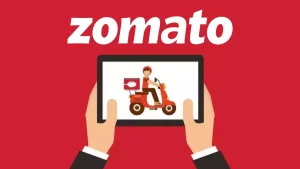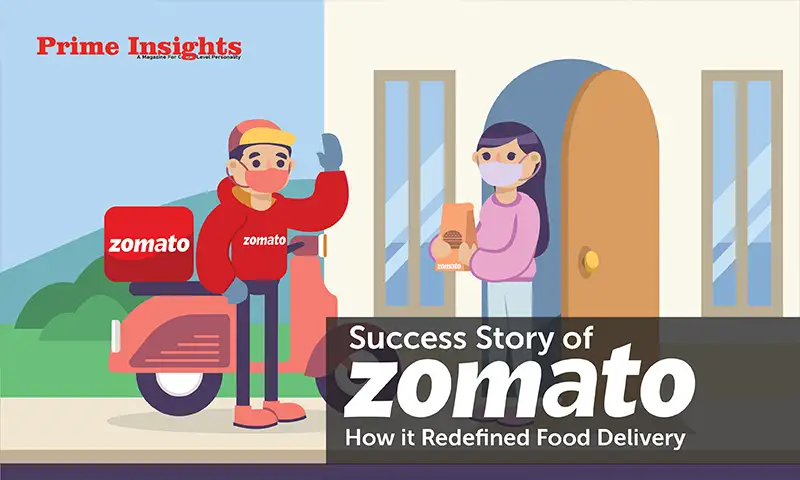Success Story of Zomato: How it Redefined Food Delivery
Introduction
Success Story of Zomato, In this article, we will look at Zomato‘s incredible path, from its humble beginnings as a restaurant discovery website to its current position as a global leader in the meal delivery sector. We’ll look at the important milestones, strategies, and innovations that have contributed to Zomato’s success.
We will also look at its global expansion, technological advances, strategic collaborations, and acquisitions. The essay will also discuss the competitive landscape, Zomato’s initial public offering, and the problems and issues it has encountered along the road.
The History of Zomato
Deepinder Goyal and Pankaj Chaddah, two young Indian entrepreneurs, had the idea for Zomato. They set out in 2008 to streamline the way customers discover restaurants and read reviews. This idea was inspired by their personal displeasure with the lack of excellent food options in their city. Zomato, their brainchild, began as a simple website that allowed users to search for restaurants, check menus, and read and post reviews.
Zomato’s user-friendly UI and extensive restaurant database set it apart. It immediately gained a devoted following among foodies who depended on it for reliable information about local restaurants. Success Story of Zomato
Zomato’s founders were tenacious in their goal of providing relevant dining information, which established the groundwork for what would eventually become a global food-tech juggernaut. This early period of Zomato’s history was marked by ambition, perseverance, and the basic premise that everyone deserves dependable restaurant information.
Zomato’s Journey
Zomato’s Business Model Evolution
From Discovery to Delivery
Zomato began as a restaurant discovery tool, giving users information about restaurants such as menus, reviews, and ratings. However, the corporation understood the changing food sector situation. Zomato took the chance to extend its services as consumer preferences switched toward the ease of food delivery. Success Story of Zomato
Key Turning Points
Zomato’s evolution was marked by important turning points and strategic decisions. It expanded into food delivery, leveraging its extensive network of restaurant partners. This adjustment in focus enabled Zomato to become a one-stop shop for restaurant discovery as well as meal delivery.
Enhanced User Experience
Zomato has made significant investments in delivering a smooth user experience. Their app and website were created to give consumers simple access to a variety of restaurants and cuisines, as well as the ability to place meal orders for delivery. The app’s user-friendly UI and features such as real-time order tracking aided in its popularity.
Consumer input
As part of Zomato’s dedication to improving user experiences, the company regularly listens to consumer input. They used this feedback to improve their services, quickly correcting faults and consistently improving their meal delivery services.
Market Expansion and Global Reach of Zomato
Zomato began as a local service in India, but it wasn’t long before it set its sights on bigger goals. Zomato went on a global expansion path after recognizing the potential in overseas markets. This growth was motivated by the desire to introduce their services to a larger and more diversified clientele. Success Story of Zomato
To expand abroad, Zomato has to traverse various cultures, cuisines, and consumer behaviors. The corporation had to tailor its services to the specific demands of each market it entered. This frequently entailed forming connections with local eateries, offering regionalized menus, and learning about regional dining patterns.
Zomato’s foreign development was both strategic and profitable. It enabled the company to diversify its revenue sources and build a global footprint. Market diversity also served as a risk mitigation approach, lowering the company’s reliance on a single market.
Zomato’s quick expansion was critical in presenting it as a global brand. The company’s ability to successfully operate in multiple nations cemented its position as a dominating player in the global food delivery market.
Zomato’s Journey
Technological Innovation
Zomato’s rise to become a food delivery behemoth would not have been feasible without its unwavering focus on technology innovation. Technology was critical in restructuring the company and distinguishing it from competitors. Success Story of Zomato
1. User-Friendly App and Website:
The user-friendly app and website were at the heart of Zomato’s technological innovation. These systems made it easy for customers to find restaurants, browse menus, read reviews, and make food orders for delivery. Customers found it simple to navigate a broad network of restaurants and cuisines thanks to the user-friendly design.
2. Real-time Order Tracking:
Zomato’s platform now includes real-time order tracking, allowing users to track the progress of their food deliveries. This addition not only offered transparency, but it also improved the overall user experience.
3. Data Analytics and Personalization:
Zomato used data analytics to learn about user preferences, dining patterns, and trends. They used this data to provide individualized recommendations to users, ensuring that they received relevant restaurant and food recommendations.
4. Machine Learning and Artificial Intelligence:
Machine learning and artificial intelligence were critical to Zomato’s success. They employed these technologies to optimize food delivery routes, reliably anticipate delivery times, and even recommend restaurant options based on a user’s previous decisions.
5. Delivery Optimization:
To streamline delivery processes, Zomato used route optimization techniques. Not only did this improve delivery times, but it also lowered the environmental effect of food delivery by optimizing delivery routes and reducing fuel use. Success Story of Zomato
6. Payment Innovations and Security:
Zomato prioritized the security of user data and financial transactions. Their ongoing efforts to secure payment gateways and ensure data privacy contributed to user trust and the platform’s overall success.
Zomato’s Partnerships and Acquisitions
Zomato’s road to becoming a global meal delivery behemoth has been aided by partnerships and acquisitions. Zomato worked strategically with restaurant owners, payment gateways, and logistics firms to grow its service network and ensure a consistent customer experience.
Notable acquisitions include UrbanSpoon and Uber Eats’ India division, which increased its market footprint in the United States and India, respectively. Mergers, such as the one with Delivery Hero in the Middle East, have hastened the company’s global expansion.
Another important tactic was acquisition diversification. Zomato’s acquisitions of companies such as NexTable and TongueStun enabled it to diversify its revenue streams and cater to different market segments. Success Story of Zomato
These collaborations and acquisitions not only broadened Zomato’s market reach but also broadened its service offerings. Zomato’s strategic expertise in forging collaborations and acquisitions has been critical to its success, allowing it to adapt to the ever-changing dynamics of the meal delivery market and preserve its leadership position.
Zomato’s Competitive surroundings
Zomato has had to traverse a crowded field of rivals in the intensely competitive meal delivery industry, continually adapting its strategy to keep its position as a market leader. The meal delivery industry is crowded with firms ranging from established behemoths to nimble startups.
Swiggy, a big participant in the Indian meal delivery sector, has been one of Zomato’s main competitors. In India, the quest for domination has resulted in intense rivalry and a constant drive for innovation. Furthermore, multinational businesses such as Uber Eats and Foodpanda have competed for a piece of the Indian market.
Zomato competes globally with companies such as DoorDash, Grubhub, and Just Eat Takeaway.com. These companies each have their own set of strengths and shortcomings, and they have aggressively competed in a variety of international marketplaces, making global expansion a difficult effort.
Zomato’s Journe
Zomato has made significant investments in technology, user experience, and partnerships in order to remain competitive. It has branched into related industries and expanded its services to incorporate features such as real-time order tracking. These actions have enabled Zomato to differentiate itself and strengthen its competitive position.
Zomato’s Journey
The Zomato IPO
Going Public
Zomato made its debut on the Indian stock market in July 2021 with an IPO that drew a lot of interest. The IPO aimed to raise funds for expansion, innovation, and debt reduction, showcasing the company’s desire to expand further. Success Story of Zomato
Valuation and Market Reaction
Investors reacted positively to Zomato’s first public offering (IPO), with the stock price skyrocketing quickly after it went public. This positive market reaction demonstrated trust in Zomato’s business concept and its future profitability prospects.
Impact on the Food Delivery Sector
The IPO of Zomato drew a lot of attention to the food delivery sector. It highlighted the market’s readiness to invest in companies that had revolutionized how people obtained food. Zomato set a pattern for others in the sector as one of the first large meal delivery platforms to go public.
Future Prospects
Going public not only pumped new resources into Zomato but also imposed new transparency and corporate governance duties. It signaled the beginning of a new chapter in the company’s history, one in which it would need to continue innovating and achieving shareholder expectations while managing the challenges and opportunities of a fast-changing sector. Success Story of Zomato
Challenges and Controversies
Zomato has had to traverse complicated regulatory frameworks in multiple countries. Local and national regulations governing food safety, licensing, and labor standards have posed challenges. Maintaining operational efficiency and profitability while adhering to these laws has been a constant struggle.
Disputes over labor policies, particularly those affecting delivery riders, have erupted. Protests and public debates have erupted over issues such as fair wages, working conditions, and rider safety. Balancing labor demands and food delivery economics is a sensitive challenge.
Social Responsibility and Community Participation done by Zomato
Zomato has shown a commitment to social responsibility by launching projects to combat hunger and food waste. Their ‘Feeding India’ program, which aims to reduce food waste and distribute excess food to those in need, demonstrates their commitment to battling hunger.
Furthermore, Zomato has engaged with local communities by creating job opportunities for delivery staff and partnering with local companies. Their efforts go beyond business, emphasizing a responsibility to positively contribute to society and inspire community participation in the communities they serve. Success Story of Zomato
Conclusion
In conclusion, Zomato’s incredible success story demonstrates its capacity to adapt and innovate in the ever-changing meal delivery sector. Zomato has redefined food delivery, expanded globally, and overcome numerous challenges since its humble beginnings as a restaurant discovery platform. Strategic alliances, acquisitions, technology improvements, and a successful initial public offering have all led to its dominance.



Comments are closed.